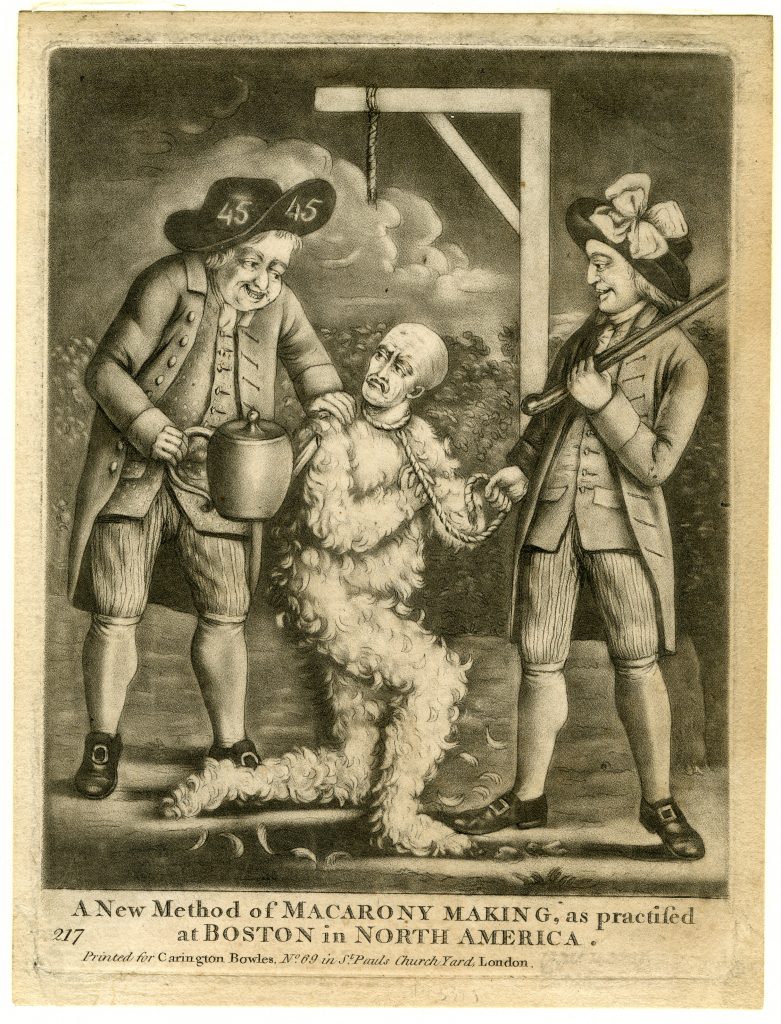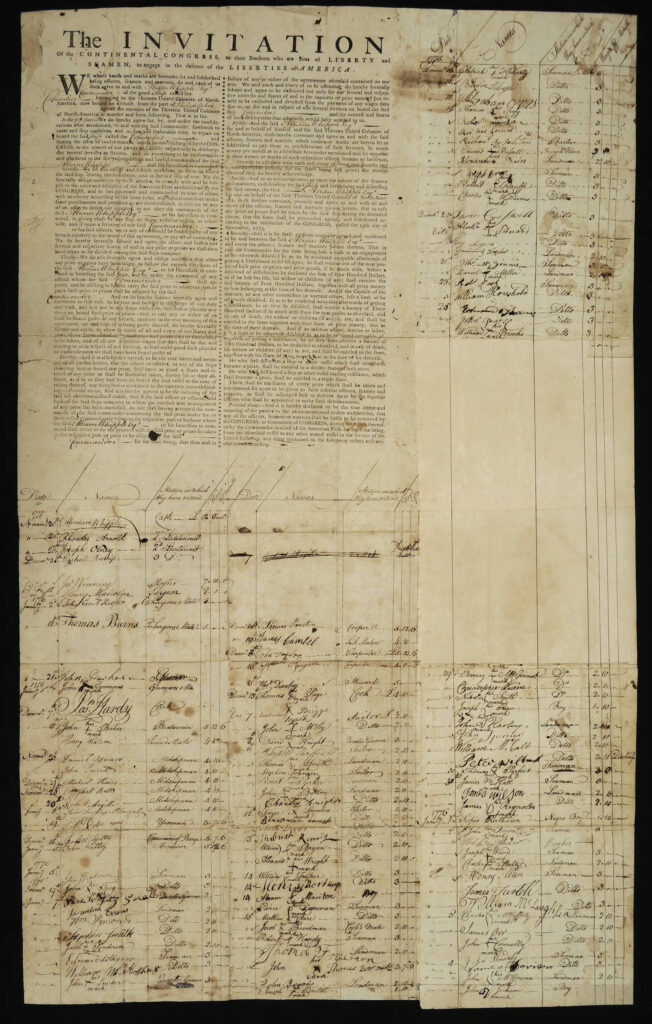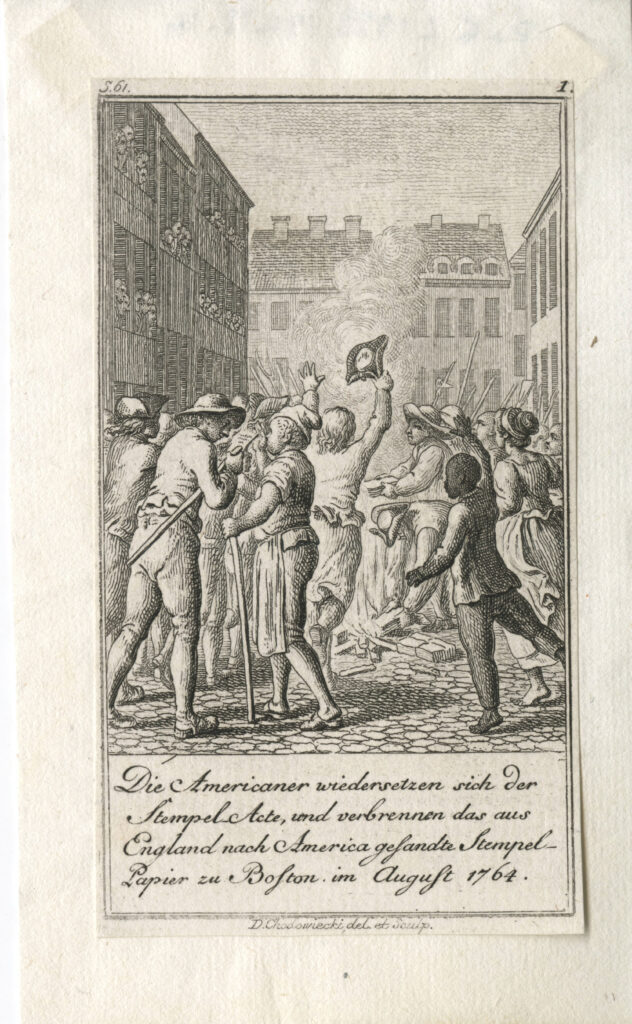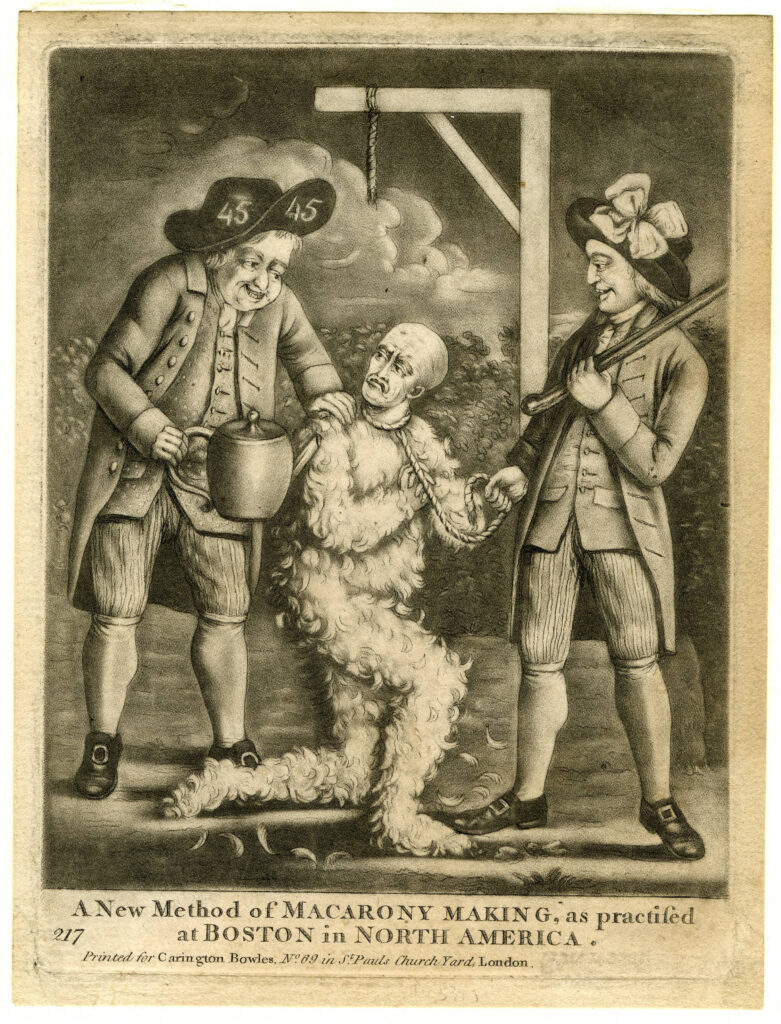Calvin Dodd, Dr. Ronald E. McNair Digital Communication and Leadership Junior High School (Florence County School District Three), Florence, South Carolina
DESIGN LEVEL: Middle-High School

Overview
In this lesson plan, students will examine the Stamp Act through various activities designed to explore its purpose, colonists’ rejection of it, and the Act’s broader implications. Students will also explore the diverse ways in which colonists protested the Stamp Act and the consequences of these protests to evaluate the effectiveness of violent forms of protest as opposed to non-violent forms of protest.
Objectives
Students will:
- Discuss factors behind the Stamp Act.
- Compare contemporary arguments for and against the Stamp Act.
- Evaluate the effectiveness of various forms of colonial protest to the Stamp Act.
Materials
Day One:
- Xia, Chen. Debt. Global Times. Cartoon. n.d.
- U.S. National Debt Clock: Real Time
- Teacher Created “Data Set of British National Debt 1690 – 1763”
- Teacher Created “Primary Source Letter [The Society of the Cincinnati]”
- Teacher Created “Stamp Act of 1765”
- Teacher Created “George Grenville’s Speech in the House of Commons, January 14, 1766”
- Dickinson, John. Letters from a Farmer in Pennsylvania. Philadelphia: T. and J. Swords, 1768. (Teacher Created “Letters from a Farmer in Pennsylvania, 1767-1768”)
- Teacher Created Venn Diagram
Day Two:
- Teacher Created Image Analysis Worksheet
- Chodowiecki, Daniel. The Americans oppose the Stamp Act and burn the stamp paper sent to America from England in Boston in August [1764 (sic)]. Berlin, 1784. The Society of the Cincinnati, The Robert Charles Lawrence Fergusson Collection. [source in color: Burning of Stamp Act, Boston. ca. 1903. Library of Congress.]
- A new method of macarony making, as practised at Boston in North America. London: Printed for Carington Bowles, 1774. The Society of the Cincinnati, The Robert Charles Lawrence Fergusson Collection.
- Teacher Created PowerPoint
- Teacher Created Document Based Questions (DBQs) Student Worksheet
- Teacher Created “New York Merchants Non-Importation Agreement (Homespun Textiles)”
- Teacher Created “Resolutions of the Stamp Act Congress”
- Teacher Created “The Examination of Doctor Benjamin Franklin by Parliament Relating to the Repeal of the Stamp Act, January 1766 [Massachusetts Historical Society]”
- Teacher Created “South Carolina Gazette Article: The Stamps Have Arrived– Public Protests Begin, October 19, 1765”
- Teacher Created “Henry Laurens, Victim of the Mob – October 23, 1765 [The Papers of Henry Laurens/South Carolina Department of Archives and History]”
Day Three:
- Year in Revolution 1775: Prelude to War, American Revolution Institute, YouTube video
- United States. Continental Congress. The Invitation of the Continental Congress, to Their Brethren Who Are Sons of Liberty and Seamen, to Engage in the Defence of the Liberties of America. Philadelphia: s.n., 1775. The Society of Cincinnati, The Robert Charles Lawrence Fergusson Collection.
- Teacher Created Rubric
Extension Activity:
Recommended Time
Three 65-minute class periods.
Lesson Activities
DAY ONE:
ESSENTIAL QUESTIONS
- What was the Stamp Act?
- What was the purpose of the Stamp Act?
- Why did the colonists reject the Stamp Act?
BELL WORK (5 minutes)
Show students the Global Times political cartoon depicting Uncle Sam in debt. Review the concept of debt, its relationship to taxes and spending, and explain the national debt in America today using the National Debt Clock.
DIRECT INSTRUCTION (20 minutes)
- Instruct students to create a graph using the “Data Set of British National Debt 1690 -1763” to introduce the issue of debt following the French and Indian War (Seven Years War). Review how to set up a graph and plot points on the X and Y axes before allowing students to work. When students have completed their graphs, review that:
- British national debt doubled after the French and Indian War (Mitchell and Deane, pp. 401-402.);
- over half of the British government’s annual budget went to pay interest on debt (Divine et al., p. 148);
- the annual cost of civil and military administration of North America was estimated to be £350,000 per year (Savelle and Middlekauff, p. 503);
- Britain did not expect its colonies to pay debt, but did expect them to help with the administrative costs to defend colonies and new territories acquired via the Treaty of Paris (Savelle and Middlekauff, p. 503).
- As a group, have students read Thomas Booth’s Letter to Reverend Richard Collinson to introduce the Stamp Act. Instruct them to circle words they do not understand, and decode them as a class. After students have time to review and possibly answer the prepared questions below the Letter‘s transcript, facilitate a discussion to model the analysis of a primary sources to use as evidence to support claims in Document Based Questions (DBQs).
- Following this discussion, review the cost of items under the Stamp Act tax, highlighting the use of the Vice-Admiralty courts, using the Teacher Created “Stamp Act of 1765” document.
GUIDED PRACTICE (20 minutes)
Instruct students to read and analyze Prime Minster Lord Granville’s and John Dickinson’s competing arguments for direct taxation of the American colonists, answering the DBQs with a partner.
INDEPENDENT PRACTICE (10 minutes)
Invite students to compare the two arguments using the Teacher Created Venn Diagram.
EXIT TICKET (5 minutes)
As a formative check, move students to different sides of the room to discuss whose opinion (the colonies’ or Great Britain’s) is justified. Call on individual students to share their perspectives.
DAY TWO:
ESSENTIAL QUESTIONS
- Is violence a legitimate form of protest?
- What was the consequence of colonial protests to the Stamp Act to British administration of the colonies (…it created a wedge)?
- Who was leading protests (…it wasn’t just rich planters and merchants)?
INTRODUCTION (10 minutes)
Invite students to analyze two engravings (“The Americans oppose…” and “A new method of…”) at the beginning of class using the Teacher Created Image Analysis Worksheet, listing observations and making initial inferences. After an appropriate wait time, ask students to share their observations and inferences to facilitate discussion, asking:
1) What do we notice in “The Americans oppose…?” (e.g. discussion: fire, pikes and pitchforks, German language);
2) What characters did you notice in “The Americans oppose?” (e.g.: women, boy, observers from balconies);
3) Who isn’t depicted in “The Americans oppose…?” (e.g.: British authorities like tax collectors and the king’s soldiers):
4) What can we tell about the beliefs of the artist of “The Americans oppose…” regarding the legitimacy of colonial protest to the Stamp Act? (e.g.: are they sympathetic with colonial protestors or British authorities?);
5) What do we notice in “A new method…?” (e.g.: ‘tar and feathering,’ attempted hanging, text indicating this is a British source);
6) What do we notice about the characters in “A new method…?” (e.g.: leering colonist versus sympathetic tax collector holding a teapot and references to Sons of Liberty with a blue bonnet and number 45 -indicating the John Wilkes Club- on colonists’ hats);
7) How does “A new method…” compare to “The Americans oppose…?”;
8) What can we tell about the beliefs of the artist of “A new method…” regarding the legitimacy of colonial protest to the Stamp Act?
Inform students that John Malcolm, a British customs official who was tarred and feathered in Boston on January 25, 1774, is the man referenced in the text of the mezzotint engraving “A new method…”. [See extensions for information concerning the eighteenth century “macaroni fashion” referenced in the text of the engraving, as well as the realities of tarring and feathering.]
DIRECT INSTRUCTION (15 minutes)
Using the Teacher Created PowerPoint, review the factors behind the creation of the Stamp Act, the arguments for and against the Stamp Act, and various forms of nonviolent and violent protests to the Stamp Act by groups like the Stamp Act Congress and the Sons of Liberty.
Highlight why the Stamp Act was repealed by Parliament in 1766, including the consequences of the Nonimportation Agreements endorsed by the Stamp Act Congress, and, passage of the Declaratory Act, which asserted Parliament’s power to legislate and impose taxes on the colonies despite the repeal of the Stamp Act (Savelle and Middlekauff, p. 514).
GUIDED PRACTICE (30 MINUTES)
Divide students into five small groups with different source sets for a “jigsaw” activity (where students work collaboratively to piece together different parts of a topic or problem using critical thinking skills).
- Source Set One (Economic Protest): Teacher Created “New York Merchants Non-Importation Agreement (Homespun Textiles)”
- Source Set Two (Diplomatic Protest): Teacher Created “Resolutions of the Stamp Act Congress”
- Source Set Three (Diplomatic Protest): Teacher Created “The Examination of Doctor Benjamin Franklin by Parliament Relating to the Repeal of the Stamp Act, January 1766 [Massachusetts Historical Society]”
- Source Set Four (Public Protest): Teacher Created “South Carolina Gazette Article: The Stamps Have Arrived– Public Protests Begin, October 19, 1765”
- Source Set Five (Vigilante/Mob Protest): Teacher Created “Henry Laurens, Victim of the Mob – October 23, 1765 [The Papers of Henry Laurens/South Carolina Department of Archives and History]”
EXIT TICKET (5 minutes)
Students should write a five-sentence paragraph comparing the effects of these protest methods on a British audience, suggesting which method would most likely be successful, and why.
DAY THREE:
ESSENTIAL QUESTION
- When is violence justified in political disputes?
INTRODUCTION (5 minutes)
Display the following primary source quotation to students as they enter the classroom:
“The opposition to the Stamp Act has been most violent, and the passions of the people are inflamed to such a degree that I fear the consequences will be dire. The damage done to property and the threats against individuals involved in the enforcement of the Act are deeply troubling.”
Washington, George. Letter to James Mercer. 19 November 1765.
Instruct students to respond to the following prompt:
“Is violence an effective form of persuasion during protests?”
After an appropriate period of time, call on students to share their responses.
Display a second primary source quotation:
“If we submit to the present taxation, it will be a great disappointment to the people and will eventually lead to armed resistance, which I believe will be necessary if our rights continue to be ignored. It is better to defend our liberties through peaceful means, but we must be prepared to take up arms if all else fails.”
Washington, George. Letter to Augustine Washington. 16 June 1769.
According to Washington’s later view, when—if ever—does violence become justified in a political movement?
DIRECT INSTRUCTION (5 minutes)
Watch “Year in Revolution 1775: Prelude to War” before reviewing key events with students and connecting the chain of causes and effects leading up to the American Revolution, from British taxes following the French and Indian War to colonial objections and protests to increasingly assertive British reprisals.
GUIDED PRACTICE (20 minutes)
Students should present their answers for each DBQ. As is needed, facilitate questions and answers with presenters to elicit key points. As each group presents, the class should individually complete each question on the answer sheet.
INDEPENDENT PRACTICE/CULMINATING ACTIVITY (30 minutes)
Direct students to create a broadside modeling the recruitment poster from the Continental Congress and Sons of Liberty using information documented on their answer sheet from the “GUIDED PRACTICE” portion of the class (using the Teacher Created Rubric). Students should assume the role of a colonial protester to create arguments convincing other colonists to voluntarily join the non-importation movement OR vigilante protest movements. Encourage students to reflect on the utility of of violence and intimidation versus propaganda in convincing others of their viewpoint. Like the primary source model “recruitment poster,” students should ideally inspire people to join their movement voluntarily rather tan force them to violently protest British policy.
In support of this activity, review the idea that: ‘During the American Revolution, the Sons of Liberty played a crucial role in organizing local militias to support the Continental Army and Navy. They helped recruit soldiers and provided logistical support, including supplies and intelligence’ (Walsh, p.140).
Each broadside should have:
- an attractive heading;
- a paragraph argument containing two points proving that the Stamp Act is unfair (using evidence from answer sheet);
- an argument concerning the utility of violence (answer sheet evidence defending idea violence is or is not justified);
- a contract to join a non-importation agreement or vigilante protest movement (including the terms of participating in each form of protest);
- a space for participants to sign.
EXIT TICKET (5 minutes)
Separate students across the classroom and invite them to voluntarily sign each other’s contracts after reading the terms for participation.
EXTENSION ACTIVITIES:
- Watch Tar and Feathering – The Realities on YouTube.
- Explore “Yankee Doodle,” a well-known American song from the eighteenth century originally sung during the American Revolution. The song’s catchy tune and playful lyrics celebrate American patriotism and mock British soldiers, with the chorus famously declaring: “Yankee Doodle went to town, riding on a pony, stuck a feather in his hat and called it macarony.” These words reflect the era’s fashion, where “macarony” was a term for androgynous, highly-styled dress. Using the popular song, and the engraving “A new method of macarony making,…” discover the extravagant world of eighteenth-century macarony fashion by creating a modern interpretation of a macarony outfit using contemporary materials. Consider how the bold patterns and exaggerated accessories of the era could be reimagined with today’s fashion trends to reflect both historical opulence and current style.
Secondary Sources
- Commons House Journal, October 28, 1765 – May 28, 1767. No. 37. Part I. Page 12. South Carolina Department of Archives and History, Columbia.
- Divine, Robert A., T. H. Breen, George Fredrickson, and R. Hall Williams. The American Story. New York: Longman, 2002.
- Hicks, Timothy E. Extraordinary & Universal Commotions: Charleston Reacts to the Stamp Act. South Carolina Council for the Social Studies State Conference, 2006.
- Mitchell, Sir George, and William Deane. The Economic History of Britain. London: Routledge, 1962. Pages 401-402.
- Savelle, Max and Robert Middlekauff. A History of Colonial America. Revised ed. New York: Holt, Rinehart and Winston, 1964.
- Walsh, Robert. Charleston’s Sons of Liberty. Charleston, SC: The History Press, 1968.
- Weir, Robert M. A Most Important Epocha: The Coming of the Revolution in South Carolina. Tricentennial Booklet Number 5. Columbia: University of South Carolina Press.
- Welling, George. “Soame Jenyns, The Objections to the Taxation of our American Colonies by the Legislature of Great Britain, briefly considered.” The American Revolution.
Standards Addressed
COMMON CORE STANDARDS
ELA-LITERACY.RH.6-8.2 / RH.9-10.2 / RH.11-12.2: “Determine the central ideas or information of a primary or secondary source; provide an accurate summary of the source distinct from prior knowledge or opinions.”
ELA-LITERACY.RH.6-8.1 / RH.9-10.1 / RH.11-12.1: “Cite specific textual evidence to support analysis of primary and secondary sources.”
ELA-LITERACY.RH.6-8.9 / RH.9-10.9 / RH.11-12.9: “Compare and contrast treatments of the same topic in different primary and secondary sources.”
NATIONAL COUNCIL FOR THE SOCIAL STUDIES STANDARDS
Standard 10: Civic Ideals and Practices: “Evaluate the role of citizens in shaping democratic institutions and practices, including the impact of civic participation on government and society.”
SOUTH CAROLINA COLLEGE- AND CAREER-READY STANDARDS FOR SOCIAL STUDIES
Standard 8-1: Understanding the Historical Context of the American Revolution: “Explain the causes and effects of the American Revolution, including the Stamp Act and other forms of colonial protest.”
Standard USHC-2: The American Revolution: “Analyze the causes of the American Revolution, including the French and Indian War, the Stamp Act, and the Boston Tea Party.”

The Invitation of the Continental Congress, to their brethren who are sons of liberty and seamen, to engage in the defence of the liberties of America
United States Continental Congress
Philadelphia?, 1775?The Robert Charles Lawrence Fergusson Collection
Printed broadside (completed in ms. through 19 January 1776) includes ms. signature lists of sailors for service on the Continental Navy ship USS Columbus under the command of Abraham Whipple of Rhode Island, including 21 officers and midshipmen; 92 seamen, landsmen, craftsmen and gunners; and a boy named Scipio Rathbun, whose occupation is given as "negro boy;" with their dates of enlistment, rank and rate of pay.Terms of agreement to be signed by sailors of private vessels entering into the service; prizes taken during the course of such service "shall be proceeded against, and distributed according to the resolution of the Congress, passed the 15th day of November, 1775."

Die Americaner wiedersetzen sich der Stempel-Acte, und verbrennen das aus England nach America gesandte Stempel-Papier zu Boston. im August 1764
Daniel Chodowiecki
Berlin, 1784The Robert Charles Lawrence Fergusson Collection
Throughout August 1765 (date in title is incorrect) there were many protests against the Stamp Act in America. This is a vignette of such a protest in Boston during which the proclamation from England is burned which was viewed as an act distroying the Crown. Vignette with title in double line border. This is the first in a series of etchings dealing with events during the American Revolution done by Chodowiecki and used is illustrations in Sprengel, Allgemeines historisches Taschenbuch, published in Berlin in 1784.
A new method of macarony making, as practised at Boston in North America
Printed for Carington Bowles...
London, 1774The Robert Charles Lawrence Fergusson Collection
Depicts two Bostonians forcing a tarred and feathered man, with a noose around his neck, to drink from a large teapot. It refers to the treatment of John Malcolm, a British customs official, on January 25, 1774. The American man holding the teapot wears a hat with "45" on it, a patriotic symbol referring to the John Wilkes case of 1763. The other American wears a large bow in his hat indicating his membership in the Sons of Liberty.